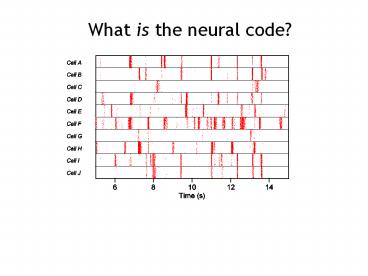What is the neural code? - PowerPoint PPT Presentation
Title:
What is the neural code?
Description:
Title: Spike coding Author: Adrienne Fairhall Last modified by: Adrienne Fairhall Created Date: 11/2/2004 8:35:29 PM Document presentation format – PowerPoint PPT presentation
Number of Views:158
Avg rating:3.0/5.0
Title: What is the neural code?
1
What is the neural code?
2
What is the neural code?
Alan Litke, UCSD
3
What is the neural code?
4
What is the neural code?
- Encoding how does a stimulus cause a pattern of
responses? - what are the responses and what are their
characteristics? - neural models
- what takes us from stimulus to response
- descriptive and mechanistic models, and the
relation between them. - Decoding what do these responses tell us about
the stimulus? - Implies some kind of decoding algorithm
- How to evaluate how good our algorithm is?
5
What is the neural code?
Single cells spike rate spike times spike
intervals
6
What is the neural code?
Single cells spike rate what does the firing
rate correspond to? spike times what in the
stimulus triggers a spike? spike intervals can
patterns of spikes convey extra information?
7
What is the neural code?
Populations of cells population
coding correlations between responses synergy
and redundancy
8
Receptive fields and tuning curves
Tuning curve r f(s)
Gaussian tuning curve of a cortical (V1) neuron
9
Receptive fields and tuning curves
Tuning curve r f(s)
Hand reaching direction
Cosine tuning curve of a motor cortical neuron
10
Receptive fields and tuning curves
Retinal disparity for a near object
Sigmoid/logistic tuning curve of a stereo V1
neuron
11
Higher brain areas represent increasingly complex
features
Quian Quiroga, Reddy, Kreiman, Koch and Fried,
Nature (2005)
12
(No Transcript)
13
(No Transcript)
14
(No Transcript)
15
More generally, we are interested in determining
the relationship
encoding
P(response stimulus)
P(stimulus response)
decoding
Due to noise, this is a stochastic
description. Problem of dimensionality, both in
response and in stimulus
16
Reverse correlation
Fast modulation of firing by dynamic
stimuli Feature extraction
Use reverse correlation to decide what each of
these spiking events stands for, and so to
either -- predict the time-varying firing
rate -- reconstruct the stimulus from the spikes
17
Reverse correlation
Basic idea throw random stimuli at the system
and collect the ones that cause a response
Typically, use Gaussian, white noise stimulus an
unbiased stimulus which samples all directions
equally
S(t)
r(t)
18
Reverse correlation
Spike-conditional ensemble
Goal simplify!
19
Example a neuron in the ELL of a fish
stimulus fluctuating potential (generates
electric field)
Spike-triggered Average
20
This can be done with other dimensions of
stimulus as well
Spatio-temporal receptive field
21
Modeling spike encoding
Given a stimulus, when will the system spike?
Simple example the integrate-and-fire neuron
22
Modeling spike encoding
The decision function is P(spikex1). Derive
from data using Bayes theorem P(spikex1)
P(spike) P(x1 spike) / P(x1)
P(x1) is the prior the distribution of all
projections onto f1 P(x1 spike) is the
spike-conditional ensemble the distribution
of all projections onto f1 given there has been a
spike P(spike) is proportional to the mean firing
rate
23
Models of neural function
spike-triggering stimulus feature
decision function
stimulus X(t)
f1
spike output Y(t)
x1
P(spikex1 )
x1
Weaknesses
24
Reverse correlation a geometric view
Gaussian prior stimulus distribution
STA
Spike-conditional distribution
25
Dimensionality reduction
The covariance matrix is given by
Stimulus prior
- Properties
- If the computation is low-dimensional, there will
be a few eigenvalues - significantly different from zero
- The number of eigenvalues is the relevant
dimensionality - The corresponding eigenvectors span the subspace
of the relevant features
Bialek et al., 1997
26
Functional models of neural function
spike-triggering stimulus feature
decision function
stimulus X(t)
f1
spike output Y(t)
x1
P(spikex1 )
x1
27
Functional models of neural function
spike-triggering stimulus features
f1
multidimensional decision function
x1
stimulus X(t)
f2
spike output Y(t)
x2
f3
x3
28
Functional models of neural function
spike-triggering stimulus features
f1
x1
decision function
stimulus X(t)
f2
spike output Y(t)
x2
f3
x3
spike history feedback
29
Covariance analysis
Lets develop some intuition for how this works
the Keat model
Keat, Reinagel, Reid and Meister, Predicting
every spike. Neuron (2001)
- Spiking is controlled by a single filter
- Spikes happen generally on an upward threshold
crossing of - the filtered stimulus
- ? expect 2 modes, the filter F(t) and its time
derivative F(t)
30
Covariance analysis
31
Covariance analysis
Lets try a real neuron rat somatosensory cortex
(Ras Petersen, Mathew Diamond, SISSA)
Record from single units in barrel cortex
32
Covariance analysis
Spike-triggered average
33
Covariance analysis
Is the neuron simply not very responsive to a
white noise stimulus?
34
Covariance analysis
Prior
Spike- triggered
Difference
35
Covariance analysis
Eigenspectrum
Leading modes
36
Covariance analysis
Input/output relations wrt first two
filters, alone and in quadrature
37
Covariance analysis
How about the other modes?
Pair with -ve eigenvalues
Next pair with ve eigenvalues
38
Covariance analysis
Input/output relations for negative pair
Firing rate decreases with increasing projection
suppressive modes
39
Beyond covariance analysis
- Single, best filter determined by the first
moment - A family of filters derived using the second
moment - Use the entire distribution information
theoretic methods
? Find the dimensions that maximize the mutual
information between stimulus and spike
Removes requirement for Gaussian stimuli
40
Limitations
Not a completely blind procedure have to
have some idea of the appropriate stimulus space
Very complex stimuli does a geometrical
picture work or make sense?
Adaptation stimulus representations change with
experience!































